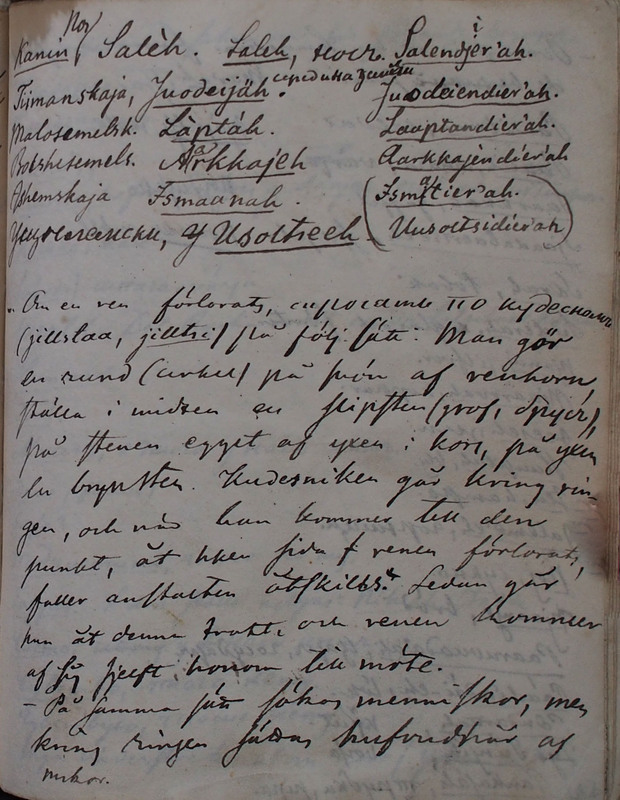Strödda ethnographiska anteckningar. 021
Title
Strödda ethnographiska anteckningar. 021
Description
|
Kanin
NosThis table summarises the regions of the Russian Arctic, their names in Russian and partly in Nenets, and the Nenets terms for those living in each region. There are some mistakes in the table, though, and this comment both normalises Castrén’s spelling and corrects some misconceptions. Kanin Nos, on the Kanin Peninsula, is Саля in Tundra Nenets. Its inhabitants are саляʹ терʹʹ, literally ʻthe inhabitants of the cape’. The Timan tundra is called Лапта (not Нюдя я) in Nenets; the inhabitants might be called лаптаʹ терʹʹ ʻthe inhabitants of the plain’. The Malozemelʹskaja tundra is called Нюдая я, literally ‘Small Land’; the inhabitants can be called Нюдя яʹ терʹʹ ʻthe inhabitants of the Small Land’. The Bolʹšezemelʹskaja tundra is called (Нг)арка я, literally ‘Great Land’; the inhabitants can be called Нгарка яʹ терʹ' ʻthe inhabitants of the Great Land’. The Nenets have been called the reindeer-herding Komi and the area where they live – whose centre Ižma is – нгысмаʹʹ. нгысмана is most probably a locative form of the word and нгысмаʹ тер' is constructed from the word, meaning ʻthe inhabitants of the Ngisma [area]’. Finally, Ustʹ-Cilʹma is, according to Castrén’s notes, Усольц in Nenets; the inhabitants are called Усольцʹ терʹʹ ʻthe inhabitants of the Usolc' [area’]. See also Dolgich 1970: 47–48 for discussion on similar concepts in research history.
|
Saleh |
носъ |
Salendje[ì]r’ah |
|
Timanskaja |
Juodeijäh |
середина земли |
Juodeiendier’ah |
|
Malosemelsk[aja]. |
Làptah |
|
Laaptandier’ah |
|
Bolshesemels[kaja]. |
Aarkkajeh |
|
Aarkkajendier’ah |
|
Ishemskaja |
Ismaanah |
|
Ismatier’ah |
|
Устцылемски |
Usoltseeh |
|
Uusoltsidier’ah |
| Om en ren förlorats, спросять по кудесномъ. (jillstaa, jilltsi)
på följ[ande]. sätt: Man görTN ильця ʻtwo objects applied to each other, used by a shaman to predict fate or when talking with the spirit of the deceased (for example, a half-full glass of water covered with a knife; two axes or knives superimposed on each other with metal parts)’. According to Lehtisalo ‘Verlosung’ TN ильцята(сь) ‘predict fate or talk with the spirit of the deceased with the help of two objects superimposed on each other’. According to Lehtisalo ‘losen (mit ainem Beil, Messer, Schäufelchen, Wasser, Branntwein, einem blanken Knopf u.a.)’. (See note [jillsi] Lehtisalo 1956: 127; Tereščenko 2003: 143)
en rund (cirkel) på snön af renhorn, ställa i midten en slipsten (grof, брусъ), på stenen egget af yxen i kors, på yxen en brynsten. Kudesniken går kring rin- gen, och när han kommer till den punkt, åt hken[hvilken] sida renen förlorats, faller anstalten åtskills. Sedan går han åt denna trakt, och renen kommer af sig sjelft honom till möte. |
If a reindeer is lost, a sorcerer is called to (jillstaa, jilltsi) in the following way: they make a circle on the snow out of reindeer antlers, set a grindstone in the middle, the head of an axe on the stone crossing it, and a whetstone on the axe. The sorcerer goes around the circle, and when he comes to the point on the side where the reindeer was lost, the device falls apart. Then he goes in that direction and the reindeer comes to meet him by itself. |
| På samma sätt sökas menniskor, men kring ringen sättas hufvudshår af mskor[menniskor]. |
Men are sought in the same way, but human hairs are put around the ring. |

